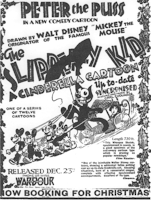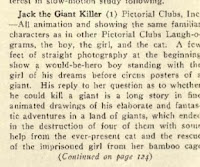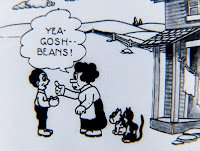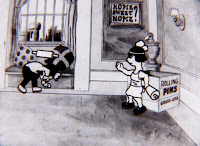 "Alice isn't Alice." Those three words recently marked the start of an exciting series of discoveries for me and others. But what could they mean?
"Alice isn't Alice." Those three words recently marked the start of an exciting series of discoveries for me and others. But what could they mean?Like a lot of cartoon researchers, I've long been disappointed that more of Walt Disney's 1920s Kansas City animation didn't seem to survive. Recently, though, colleagues and I have turned up some exciting discoveries—some of which, I'm pleased to announce, are about to reach public eyes after a long, long absence.
First, a bit of background. Until recently, it was believed that only four of Disney's Laugh-O-Grams fairy tale cartoons still existed: Little Red Riding Hood, Puss in Boots, Cinderella, and The Four Musicians of Bremen (all 1922). It was also conventional wisdom that the fairy tales had been a series of six, released only in the United States—and perhaps only in part; for soon after buying the series from Disney, non-theatrical distributor Pictorial Clubs of Tennessee filed for bankruptcy.
But Pictorial Clubs had shady sister companies in different states. Some, it turns out, continued to distribute Laugh-O-Grams years later; all seven of them, not six. Jack and the Beanstalk and Jack the Giant Killer (both 1922), two titles traditionally misremembered as one and the same, were actually different shorts. A 1922 press release, discovered by researcher Michael Barrier, announced that the series would include both titles; John Kenworthy noted the two titles listed as separate, completed cartoons among Laugh-O-Gram Films' bankruptcy records.
 As the sound era dawned, the seven fairy tales changed owners. As early as 1991, J. P. Storm and M. Dreßler's pivotal German study Im Reich der Micky Maus included German release information for a 1929 Disney cartoon series entitled "Wuppy"; in his Animated Film Encyclopedia (2000), Graham Webb revealed an American equivalent alternately titled "Whoopee Sketches" and "Peter the Puss." Bollman and Grant were credited as producers for the New York-based Sound Film Distributing Corp.; in England, Wardour Films distributed the reels theatrically.
As the sound era dawned, the seven fairy tales changed owners. As early as 1991, J. P. Storm and M. Dreßler's pivotal German study Im Reich der Micky Maus included German release information for a 1929 Disney cartoon series entitled "Wuppy"; in his Animated Film Encyclopedia (2000), Graham Webb revealed an American equivalent alternately titled "Whoopee Sketches" and "Peter the Puss." Bollman and Grant were credited as producers for the New York-based Sound Film Distributing Corp.; in England, Wardour Films distributed the reels theatrically. Webb was the first to verify that these Whoopee/Peter titles were Laugh-O-Grams retrofitted with soundtracks—with "Peter the Puss" being a new name for Disney's Julius the Cat (or his Laugh-O-Gram prototype). The Whoopee/Peter title "Grandma Steps Out" turned up in the collection of David Wyatt, and was clearly Disney's Little Red Riding Hood. Webb tagged Disney's Cinderella (1922) as the Whoopee/Peter "The Slipper-y Kid," Goldie Locks and the Three Bears (1922) as "The Peroxide Kid," and Puss in Boots as "The K-O Kid."
Webb was the first to verify that these Whoopee/Peter titles were Laugh-O-Grams retrofitted with soundtracks—with "Peter the Puss" being a new name for Disney's Julius the Cat (or his Laugh-O-Gram prototype). The Whoopee/Peter title "Grandma Steps Out" turned up in the collection of David Wyatt, and was clearly Disney's Little Red Riding Hood. Webb tagged Disney's Cinderella (1922) as the Whoopee/Peter "The Slipper-y Kid," Goldie Locks and the Three Bears (1922) as "The Peroxide Kid," and Puss in Boots as "The K-O Kid."But there were more Whoopee/Peter titles than there were Laugh-O-Gram fairy tales. Some records suggested 12 Whoopee cartoons were released; nine made it to Germany, and Storm/Dreßler and Webb collectively found title listings for ten. Would we ever actually see the films to conclusively identify them all?
"Alice isn't Alice." In 2005, researcher Cole Johnson told me about having screened a misidentified cartoon at the Museum of Modern Art. Though tagged as Disney's Alice and the Three Bears (1924)—as it had been since its acquisition, decades before—this cartoon didn't feature a live-action Alice, as was SOP for the Alice Comedies. Instead Alice was animated. Or was it Alice? Cole believed we were seeing Goldie Locks, and the print title, "The Peroxide Kid," guaranteed it. Exceptional find, Cole.

Where one retitled print existed, might there be more? Sure enough. In time, MoMA proved to possess other previously unprovenanced reels that, when inspected, revealed Whoopee and/or Peter main titles. Now the discoveries, and confirmed identifications, flew thick and fast. Two Whoopee Sketches, "Rural Romeo" and "Egg-Splosion," turned out not to be Disney shorts. As for those that were, we already knew "Grandma" was Red Riding Hood and "Peroxide" Goldie Locks; now "The Four Jazz Boys" was confirmed as Bremen, while helpful MoMA staffers found for me that "The Cat's Whiskers" matched Disney's Puss in Boots.
 Of course, if "Whiskers" was Boots, then Webb had been incorrect with one title assignment. What was "The K-O Kid"? MoMA had a film element bearing that title, but it was not screenable when I did my initial research last fall. Luckily, a 1969 MoMA plot synopsis survived—and matched up point for point with a 1924 review of Jack the Giant Killer (above), which I'd located in The Educational Screen non-theatrical exhibitors' magazine. Shortly after, another print also turned up at MoMA; now elements of both have been combined and Giant Killer properly restored and preserved.
Of course, if "Whiskers" was Boots, then Webb had been incorrect with one title assignment. What was "The K-O Kid"? MoMA had a film element bearing that title, but it was not screenable when I did my initial research last fall. Luckily, a 1969 MoMA plot synopsis survived—and matched up point for point with a 1924 review of Jack the Giant Killer (above), which I'd located in The Educational Screen non-theatrical exhibitors' magazine. Shortly after, another print also turned up at MoMA; now elements of both have been combined and Giant Killer properly restored and preserved. In the shuffle, one might have forgotten Jack and the Beanstalk, on which no element has yet turned up at MoMA. With luck, however, I did locate an element in a private collection last spring; once again under its Peter the Puss title, "On the Up and Up." Thus all seven Laugh-O-Gram fairy tales have now been found.
In the shuffle, one might have forgotten Jack and the Beanstalk, on which no element has yet turned up at MoMA. With luck, however, I did locate an element in a private collection last spring; once again under its Peter the Puss title, "On the Up and Up." Thus all seven Laugh-O-Gram fairy tales have now been found.Want to see some? Sure you do. And that leads me to more good news—some will be screened, and soon. This October 31 will bring us a Halloween treat: longtime silent film scholar and fellow cartoon researcher, Serge Bromberg, is coming from Europe for MoMA's annual To Save and Project festival, and he'll be presenting a special Laugh-O-Grams program. Along with now-preserved prints of Little Red Riding Hood, Puss in Boots, and Four Musicians of Bremen, the newly discovered Jack the Giant Killer and Goldie Locks and the Three Bears will also be shown. Serge will provide his usual stellar background info and piano accompaniment. And as icing on the cake, later Ub Iwerks cartoons will also be at the screening, including Flip the Frog's Techno-Cracked (1933) and my personal favorite, Don Quixote (1934).
Can't make it on the 31st? Come on November 4. This is one time when cartoon research has gotten great results—for Cole Johnson, Serge, the MoMA staff, and myself.
 Any other points to add? Yes: together with Beanstalk in the private collection was a print of Cinderella, restoring a long-lost final scene (at right) coming after the end of Disney's current element. Looks like Cindy and Prince Charming didn't live happily ever after.
Any other points to add? Yes: together with Beanstalk in the private collection was a print of Cinderella, restoring a long-lost final scene (at right) coming after the end of Disney's current element. Looks like Cindy and Prince Charming didn't live happily ever after.And the latest Whoopee Sketch rundown, as of now:
(Whoopee title • original title)
"Bottle of Rum" = ?
"The Cat's Whiskers" = Puss in Boots
"Egg-Splosion" = non-Disney Bill Nolan short
"The Four Jazz Boys" = Four Musicians of Bremen
"Grandma Steps Out" = Little Red Riding Hood
"The K-O Kid" = Jack the Giant Killer
"On the Up and Up" = Jack and the Beanstalk
"The Peroxide Kid" = Goldie Locks and the Three Bears
"Rural Romeo" = non-Disney Bill Nolan short
"The Slipper-y Kid" = Cinderella
Anyone got that "Bottle of Rum"? LeChuck? Jack Sparrow?... Bootleg Pete?
Special thanks to J. B. Kaufman, Tom Stathes, Timothy Susanin, Michael Barrier, Didier Ghez, Leonard Maltin, Jerry Beck, and Thad Komorowski.